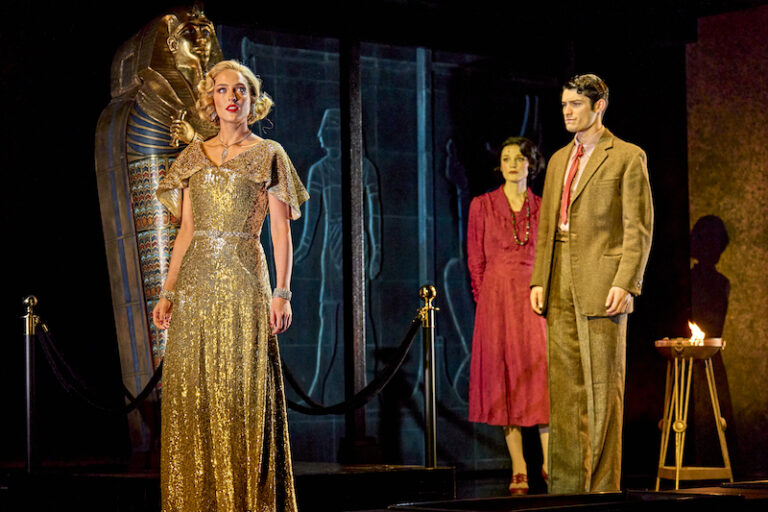Writer: Ken Ludwig after Agatha Christie
Director: Lucy Bailey
The murder mystery depends, for its success, on the deliberate deception of the audience. Unlike other forms of drama in which the audience is privileged with additional insight into the inner lives of the characters, the murder mystery deliberately withholds information. On the contrary, the drama asks us to step into the role of the detective and to decipher the hidden motive of the suspects. It’s a plot device frequently deployed in prose (where the narration is selective) and in cinema (where we are limited by the field of vision of the camera), but the enactment of the murder mystery on a stage is a more challenging affair.
Death on the Nile executes this staging of a classic Agatha Christie murder mystery by successfully maintaining the aura of exotic mystery associated with such dramas, whilst also adding a few theatrical flourishes of its own. At times, it teeters on the edge of cliché and risks becoming formulaic – but it narrowly avoids doing so by adopting a few meta-theatrical nods to its source material – acknowledgements that the murder mystery trope is a dramatic formula that needs to be strictly followed.
Writer Ken Ludwig and Director Lucy Bailey have made a wise directorial choice here not to stake any claim to originality, but instead to revel in the trope – to embrace murder mystery conventions wholeheartedly, whilst occasionally even poking fun at its traditions (at one point, Poirot even announces that he will now call everyone back into the room to reveal his discoveries, his ‘favourite part’ of the conventional proceedings).
The setting: a river steamer aboard the Nile – a perfect microcosm for a murder because no one can get on or off. The setup: newlyweds Linnet Ridgeway-Doyle (played by Libby Alexandra-Cooper) and Simon Doyle (played by Nye Occomore) are celebrating their honeymoon on an exotic cruise. Unfortunately, the cruise also happens to harbour a multitude of interconnected people, each with a murky morality and potentially murderous motives. First and foremost among them is the femme fatale, Jacqueline de Bellefort ( Esme Hough), Simon’s ex-lover. It’s a potent and deadly combination – and, in true murder mystery style, sets up a plethora of characters, each equally suspicious and with their own individual justifications for murder.
This production must contend with several obstacles: the audience knows that a murder will occur, and those more familiar with Christie may know the outcome. Therefore, the experience must, first and foremost, be fun. Director Lucy Bailey really leans into this challenge: her characters are hyperbolic, brash and brazen, a garish pastiche of 1930s British society. Together with designer Mike Britton, she has assembled a beautiful set, dripping with the Western perception of Egyptian charm (Edward Said’s Orientalism comes to mind). Carvings of Egyptian myths layer across the background of the first scene – Anubis weighing the souls of the dead, Osiris and Isis, to name a few.
The grand set piece is a giant golden Sarcophagus: Ken Ludwig’s addition to this Christie Classic, and something of a Chekhov’s gun, which culminates in a melodramatic twist. Most of the play is set aboard the ship, depicted using a backdrop of a dual level of wooden cabins and luxurious colonial furniture, which is swiftly placed and removed. It’s a well-thought-out set; in particular, the use of neighbouring wooden doors to cabins allows the sense of multiple events and narratives happening at once.
Where this production falls down, however, is in the rushed revelation of the murderer’s motives. Mark Hadfield plays Hercule Poirot with effervescent energy: his detective is apparently wise, perceptive and attuned to the motives of the characters around him. But when it comes to that all-important climax – the post-murder sleuthing and discovery scene (a trope conjured up for many by the ‘let’s split up and search for clues!’ maxim), he debunks the murder plot with such frightening alacrity that it feels falsified. Aspects of the original plot do, of course, need to be cut in order for this to be successfully staged, but the audience cannot help but feel rushed through the passage of discovery, which is a rite of passage for all works of this type.
Taken as a whole, this production is generally a successful adaptation of a cult classic by the Queen of Crime herself. Although rushed and clichéd at moments, it adds just enough new flavour (the Sarcophagus scene, new characters and a masterful set) without overly diverging from the tropes and themes which make up the DNA of the murder mystery. To this, it adds a sprinkling of self-awareness, taking the time to mock some of the sillier aspects of the genre. A talented cast brings the insufferable nature of Christie’s characters to life with amusing hyperbole, assisted, in their garish period dress, by an ambitious costuming team (Sarah Holland and Elizabeth Marini). It’s Death on the Nile, but there is no attempt at denial of its heritage: this is a tribute to a well-loved classic, brought carefully forth from the burial tomb, and into the scorching sun of the stage.
Runs until 11 October 2025 and continues to tour

